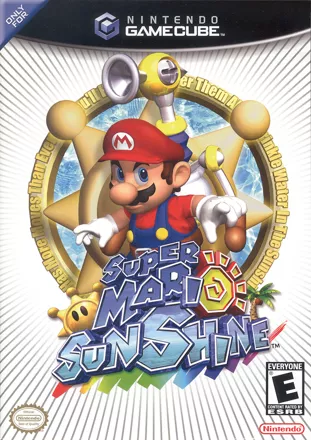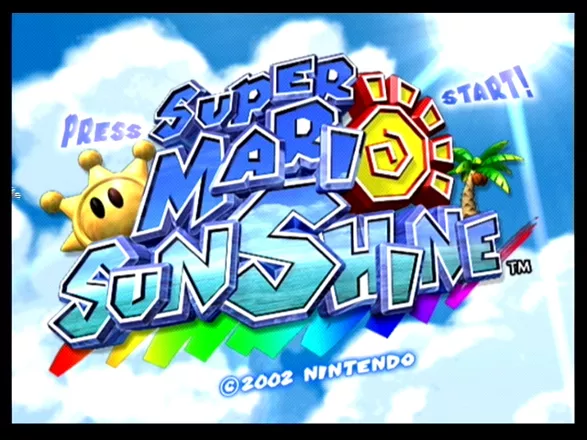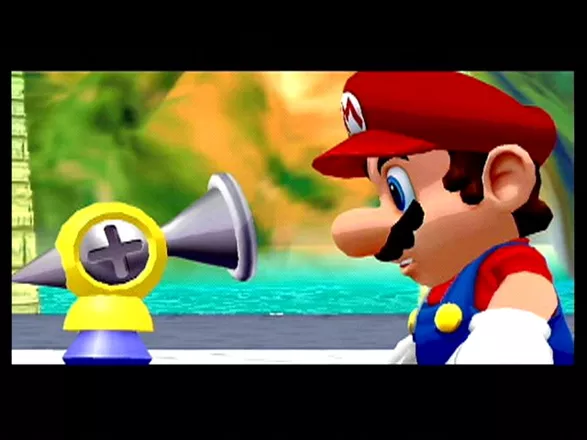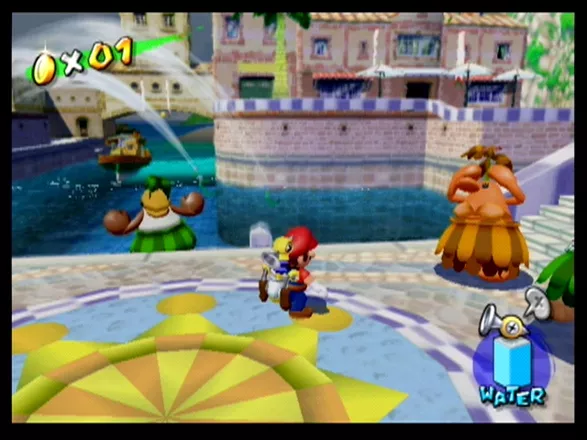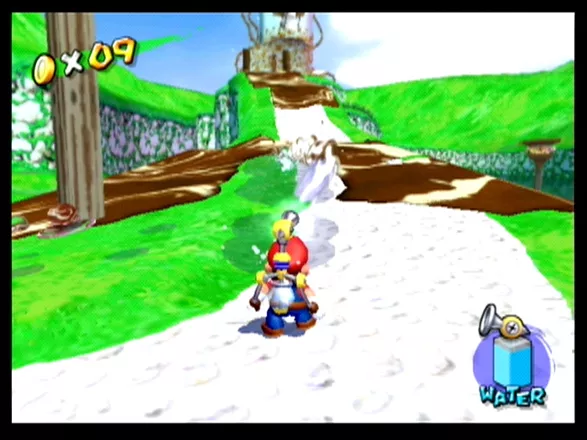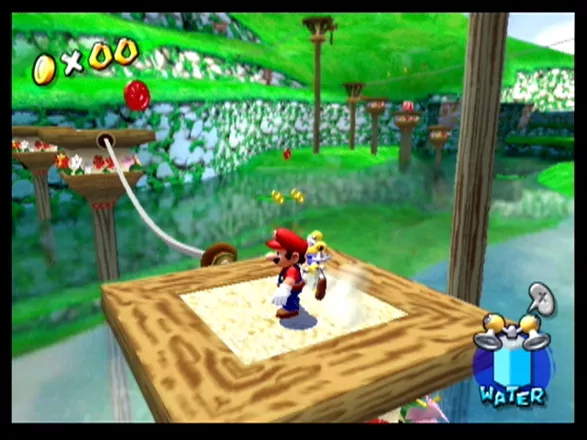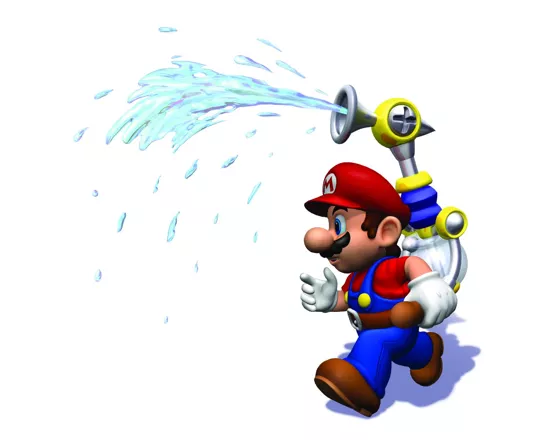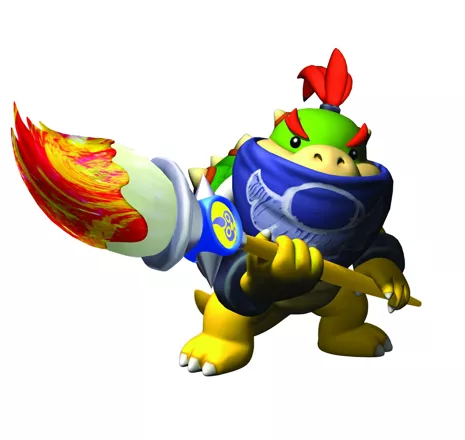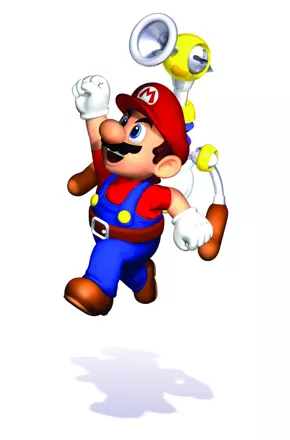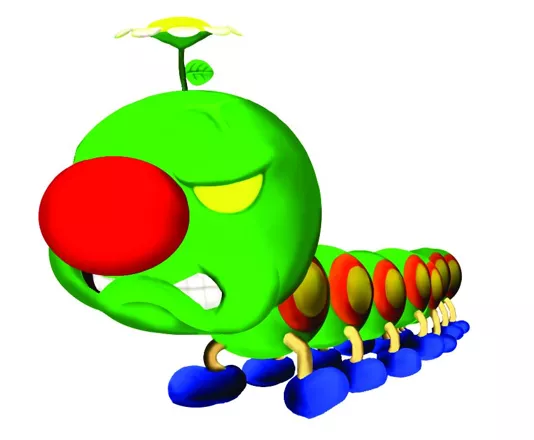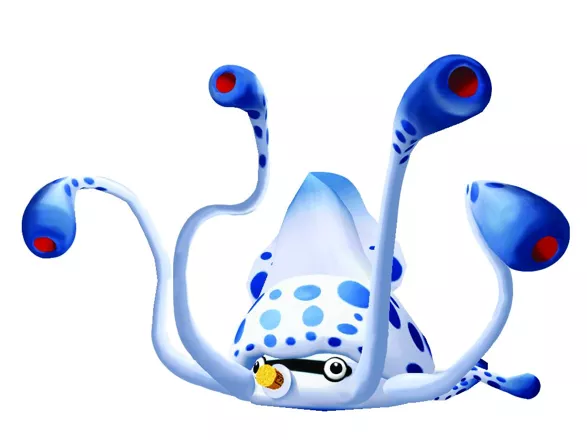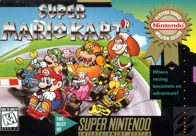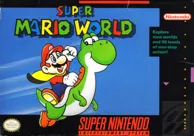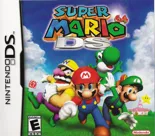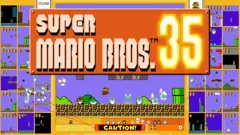Super Mario Sunshine
Description official descriptions
Mario, Princess Peach, Toadsworth, and Toad have come to Isle Delfino for some relaxation. Upon arrival, however, they discover the island has been polluted causing its energy source, the Shine Sprites, to disappear. The culprit is similar in appearance to Mario, who is blamed for the mess, so the portly plumber is forced to clean up the island. Mario is given an invention called FLUDD (a backpack with several water nozzles) to help him clean up graffiti and mud and capture the real villain. Gameplay features a combination of action and puzzle solving, with numerous stages and multiple episodes to each stage, and plenty of hidden secrets and surprises.
Spellings
- スーパーマリオサンシャイン - Japanese spelling
- 슈퍼 마리오 썬샤인 - Korean spelling
Groups +
Screenshots
Promos
Videos
See any errors or missing info for this game?
You can submit a correction, contribute trivia, add to a game group, add a related site or alternate title.
Credits (GameCube version)
100 People (76 developers, 24 thanks) · View all
| Executive Producer | |
| Producers | |
| Directors | |
| Map Director | |
| Assistant Directors | |
| Character Design | |
| Map Design | |
| Map Object Design | |
| Screen Design | |
| [ full credits ] | |
Reviews
Critics
Average score: 87% (based on 69 ratings)
Players
Average score: 3.9 out of 5 (based on 149 ratings with 8 reviews)
The Good
The movement is tight, the locales interesting to explore, and it looks gorgeous too. The blue coins give the player an extra incentive to explore every corner of its levels, each of which is carefully crafted to be a playground where the player can have fun with the mechanics.
The Bad
Some levels in this game are just too hard. Pachinko comes to mind. The lilypad level is also diabolical.
The Bottom Line
This game improves on its predecessor in every way. Mario 64 established the 3D platformer formula and this game perfected it.
GameCube · by Tedder (1) · 2025
A great follow up to Mario 64.
The Good
The thing that standed out the most were the graphics and the wide variety of colors. The graphics were very detailed (especially the water in the harbor level). The colors were eye-popping and a upgrade from Mario 64.
The Bad
The 2 things I didn't like were the music and the voice text. The music was corny and boring like in the other Mario games. Plus, the music overshadowed the voices in the game. Peach's voice was scrambled and the Toads just made funny noises.
The Bottom Line
You feel like you got your money's worth with this game. If you like Mario games or games with a mixture of humor and seriousness, you should buy this game.
GameCube · by Exodia85 (2144) · 2003
A vacation from the Mushroom Kingdom - lighten up and enjoy it.
The Good
1) Above all, the music is the best thing in the game. Koji Kondo has decades of experience doing his thing, and despite the continued use of MIDI sounds, SMS is some of the tightest platform music ever. It manages to convey a "feel" for the spirit of the game, reflect the tropical surroundings, and move the action/mood of the game forward all at the same time. It's really amazing what the music does for the game, and it should serve as an example for other platformers as to how easily a game is enhanced with quality stage ditties.
2) Nintendo manages to convincingly incorporate the new scenery and characters into the Mario world. I'm typically pretty picky about arbitrary additions to Mario/DK (Rare's Kongs, I'm looking at ALL of you), but I think the Piantas, Petey Piranha, etc are okay additions. Like I said, I'm not crazy about them, but I think they're not as offensive as other attempts to expand the Empire.
3) For all the grief it takes, the water pack is still a fun little gadget for platform gaming. C'mon, you know you enjoy blasting bee hives and anthropomorphic venus fly traps. It's fun!
4) Good level design in that the same level is used repeatedly for different objectives but fails to become stale thanks to the water pack tricks "opening" new areas of each level to explore.
5) Though not as impressive as the music, which I feel is up there with the best of any platformer I've played, the visuals are lush and stunning. The coronas produced by aiming your camera into the sun are a nice touch. Good looking game in many respects.
6) Play control is fairly tight. I would say "absolutely tight" if it weren't for the blasted camera in a few choice areas, which I'll mention in the "Bad."
The Bad
1) Though I love the Mario world, STOP MAKING MARIO GAMES INTO COLLECT-FESTS!!! I can't say that emphatically enough. I loved the use of coins, flowers, and stars to give Yoshi's Island some extra replay, but the "Shine Get!" collect-fest is too much, Nintendo. I'm praying it's not a sign of things to come in the Mario Universe (though I know better).
2) The camera, while good in many places, is so bad in a few places as to negate all the good. I'm sure that a lot of work goes into making things work in this game, and I've given Nintendo more than enough credit in the "Good" section for some of those things. But to have bad camera control after the design experience of Mario 64 (which had a better camera, IMHO) is inexcusable.
3) Not really many fun "secrets" in this place, like SMB's so-called negative world, SMB3's warp whistles, or SMW's Star Road. Would have been a nice touch.
4A) I found most of the boss fights boring. I'm being picky on this one, but I thought I'd throw it out there. They just didn't excite me, maybe because the non-conventional structure of the game didn't make things feel to me like things were "building-up" to a boss fight.
4B) This ties in with 4A: I felt the incorporation of the "bad guys" and boss fights wasn't well considered. The jump to the fight with Bowser Sr. seemed sudden to me--I understand the big "build-up" to the final fight is easier when the worlds and levels/stages are numbered, and you know how far you've got until the big battle, but Nintendo should have thought of a non-traditional way to incorporate the final fight to match the non-traditional themes (for a Mario game/platformer, at least) in the remainder of the game.
5) Finally, I'm about the only person I know who thinks that the "old school" SMB-in-3D bonus stages were entirely unnecessary. I think they're a concession to Mario fans thrown in by the game's designers because they were worried this vacation would be too "different" for Mario fans. I dislike those bonus stages because they deviate from the theme of the game. Instead of bonus stages, I would've appreciated it if the designers put more thought into how to fit the bosses and boss fights into the game more cleverly.
The Bottom Line
The title of this review says it all. This game is clearly a "vacation" from the Mario series--everything in the design is screaming it: for example, the mushrooms, fire flowers, and goombas take a backseat to palm trees, evil goop, and durian kicking.
People who expected this game to be the fabled "Mario 128" or a true successor to Mario 64 aren't being fair to the game or the game's creators. Again, it's pretty clear from everything in the game (from the opening FMV of Mario's flight to the use of tricks and devices unfamiliar to the rest of the Mario world) that this game was designed to be not just a vacation for Mario but for his fans as well.
As a goofy aside (but one I'll try to relate to the overall message), I have a condition in which I often experience music as flavors, and whenever I play SMS or even just hear its music, I have the sensation of tasting fresh, slightly unripe mangoes on the roof of my mouth. And to me, that image is the intent with this game: it's not meant to be a heavy flavor, like ice cream or a thick sauce, but instead light, bright, and flavorful, like a sweet, slightly tart young mango or a citrusy sorbet.
If you dislike SMS, you should dislike it for being "light, bright, and flavorful." But don't dislike it for reasons its creators can't control. I like the game because I take it for what it is: a fun game that's very easy to pick up and play for a half of an hour or so. In the space of time you play it, you'll typically find yourself humming along to music and enjoying the sun-drenched visuals and relaxed characters and surroundings. A great addition to any GC library.
GameCube · by MagFram (33) · 2005
Trivia
1001 Video Games
Super Mario Sunshine appears in the book 1001 Video Games You Must Play Before You Die by General Editor Tony Mott.
Bugs
There is a major glitch in the game that allows you to access a sub world, sometimes called the "Blue Hell". The game physics are dropped down (meaning, for example, you can move around normally underwater, but if you jump it will revert to normal) and you can access many areas with little or no effort, particularly the Yoshi fruit boats.
Japanese version
In the Japanese version of Super Mario Sunshine, "Isle Delfino" is known as "Dolphic Island". When a player retrieves a Shine Sprite, the "message" says "Shine Get!" instead of the English "Shine!" Also, despite being developed in Japan, the Japanese version is all in English with Japanese subtitles.
References
- This game is set on a tropical island named Isle Delfino. "Delfino" is Italian for "Dolphin", which was Gamecube's prototype's name. Also, there are some words written in Italian around the game, like "Benvenuto" ("welcome"), etc.
- There's a reference to the Beatles in this game. There is a yellow submarine on the Ricco Harbor stage.
- In the attic of the Hotel Delfino, the janitor complains about the ghosts, wishing someone would come and "suck them up in a vacuum cleaner". This is a reference to another Gamecube title, Luigi's Mansion, where Luigi did indeed suck up ghosts in a vacuum cleaner.
- When you first find FLUDD, look in the lower left corner to view scenes from previous Mario games, including Super Mario Bros., Super Mario World, and Super Mario 64.
Awards
- 4Players
- 2002 – Best GameCube Game of the Year (Readers' Vote)
- 2002– Best GameCube Dexterity Game of the Year
- 2002 – Best GameCube Dexterity Game of the Year (Readers' Vote)
Information also contributed by Ben Miller, gamewarrior, MegaMegaMan, and Tiago Jacques
Analytics
Upgrade to MobyPro to view research rankings and price history! (when applicable)
Related Sites +
-
Super Mario Sunshine
Nintendo's Official Site.
Identifiers +
Contribute
Are you familiar with this game? Help document and preserve this entry in video game history! If your contribution is approved, you will earn points and be credited as a contributor.
Contributors to this Entry
Game added by Servo.
Additional contributors: JPaterson, okJigu, Guy Chapman, Alaka, gamewarrior, Patrick Bregger, Rik Hideto, FatherJack.
Game added August 28, 2002. Last modified December 28, 2024.


